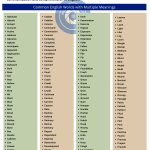Parallel Structure
Parallelism (also known as parallel structure) is a crucial grammar concept that refers to the use of components in a sentence that are grammatically similar or identical in structure, sound, meaning, or rhythm. This technique improves readability, clarity, and balance in writing. Let’s dive deeper into parallelism, its importance, and examples.
What is Parallelism?
Parallelism is the repetition of grammatical structures in writing to create a sense of symmetry and balance. When ideas or actions in a sentence are related or compared, they should be expressed in similar grammatical form. This makes sentences smoother and easier to follow, while adding a sense of rhythm and harmony.
Why is Parallelism Important?
- Clarity: Parallelism ensures that sentences are clear and easily understandable.
- Readability: It improves the flow of the sentence, making it more pleasant to read.
- Consistency: Parallel structure ensures consistency in writing, which enhances the overall quality.
- Emphasis: By repeating a structure, writers can emphasize important ideas or actions.
Examples of Parallelism in Sentences
Incorrect: She likes cooking, to jog, and reading.
Correct: She likes cooking, jogging, and reading.
In this example, all activities are nouns in their gerund form (“-ing”). Keeping the form consistent maintains the sentence’s clarity.
Incorrect: He is smart, diligent, and works hard.
Correct: He is smart, diligent, and hardworking.
The adjectives in the correct sentence are aligned, making it parallel.
Incorrect: The job requires attention to detail, being organized, and you must have strong communication skills.
Correct: The job requires attention to detail, organization, and strong communication skills.
Here, nouns are used in all three components to maintain the parallel structure.
How to Identify and Fix Non-Parallel Sentences
To ensure parallelism:
- Look for items in a list or series.
- Make sure each item is in the same grammatical form, such as all verbs, all nouns, or all adjectives.
Non-Parallel Example:
- Incorrect: I came, I saw, and was conquering.
- Parallel: I came, I saw, I conquered.
Types of Parallelism
Parallelism in Lists: Items in a list must have the same grammatical form.
- Example: The manager praised his staff for their dedication, hard work, and punctuality.
Parallelism in Comparisons: When comparing two things, use the same structure.
- Example: She is more interested in writing than in speaking.
Parallelism with Conjunctions: When using coordinating conjunctions like “and” or “or,” maintain the same structure for the ideas they join.
- Example: You can either come with us or stay at home.
Parallelism in Writing
In professional writing, especially academic and formal texts, parallelism is important for maintaining a structured, logical flow. It makes the text easier to read and emphasizes critical points. For example, in speeches and persuasive writing, parallel structure can make ideas more memorable.
Example from a Speech:
- “We shall fight on the beaches, we shall fight on the landing grounds, we shall fight in the fields and in the streets.”
— Winston Churchill
In this quote, Churchill repeats the structure “we shall fight” to create a powerful rhetorical effect.
Parallelism vs. Repetition
While parallelism uses repetition of grammatical structure, it is different from repetition in the sense that it doesn’t merely repeat words but emphasizes balance in grammatical forms. Repetition often involves restating key words or phrases for emphasis, while parallelism focuses on sentence structure.
Common Errors in Parallelism
Mismatched Verb Tenses: Mixing past, present, and future tense can disrupt parallelism.
- Incorrect: He enjoys hiking, to swim, and biking.
- Correct: He enjoys hiking, swimming, and biking.
Unequal Comparisons: When comparing, both sides of the comparison must match.
- Incorrect: She likes playing basketball more than to play soccer.
- Correct: She likes playing basketball more than playing soccer.
Parallelism is a vital component of effective writing. It enhances readability, clarity, and persuasiveness. By maintaining a balanced grammatical structure, writers can convey ideas more clearly and emphasize their message. Whether you’re writing for academic, professional, or casual purposes, mastering parallelism will improve your overall writing quality.





